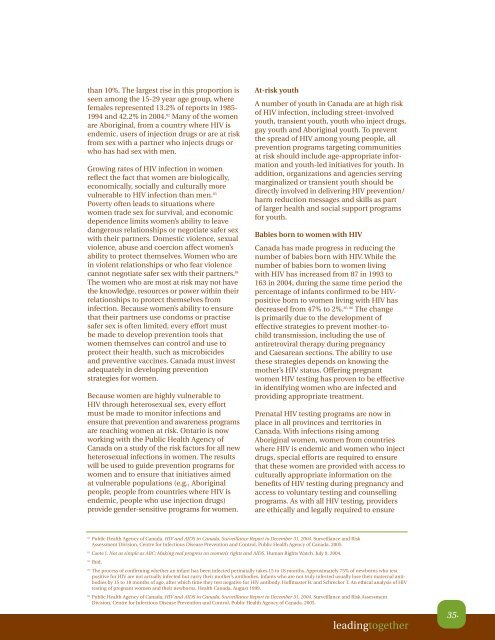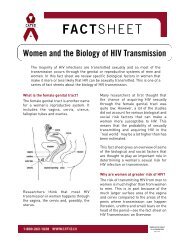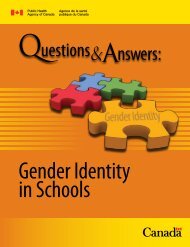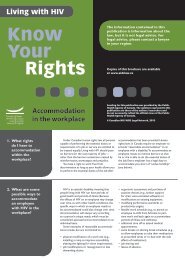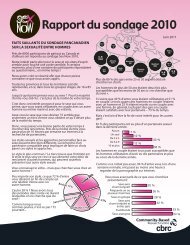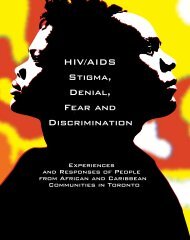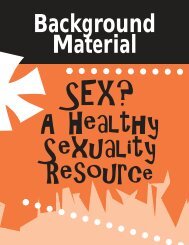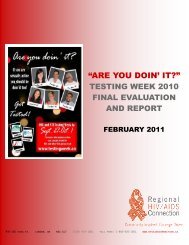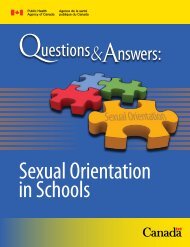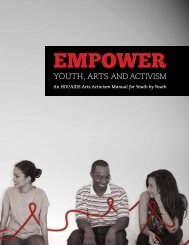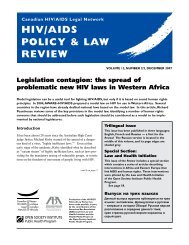leadingtogether: - CATIE
leadingtogether: - CATIE
leadingtogether: - CATIE
- No tags were found...
Create successful ePaper yourself
Turn your PDF publications into a flip-book with our unique Google optimized e-Paper software.
than 10%. The largest rise in this proportion isseen among the 15-29 year age group, wherefemales represented 13.2% of reports in 1985-1994 and 42.2% in 2004. 82 Many of the womenare Aboriginal, from a country where HIV isendemic, users of injection drugs or are at riskfrom sex with a partner who injects drugs orwho has had sex with men.Growing rates of HIV infection in womenreflect the fact that women are biologically,economically, socially and culturally morevulnerable to HIV infection than men. 83Poverty often leads to situations wherewomen trade sex for survival, and economicdependence limits women’s ability to leavedangerous relationships or negotiate safer sexwith their partners. Domestic violence, sexualviolence, abuse and coercion affect women’sability to protect themselves. Women who arein violent relationships or who fear violencecannot negotiate safer sex with their partners. 84The women who are most at risk may not havethe knowledge, resources or power within theirrelationships to protect themselves frominfection. Because women’s ability to ensurethat their partners use condoms or practisesafer sex is often limited, every effort mustbe made to develop prevention tools thatwomen themselves can control and use toprotect their health, such as microbicidesand preventive vaccines. Canada must investadequately in developing preventionstrategies for women.Because women are highly vulnerable toHIV through heterosexual sex, every effortmust be made to monitor infections andensure that prevention and awareness programsare reaching women at risk. Ontario is nowworking with the Public Health Agency ofCanada on a study of the risk factors for all newheterosexual infections in women. The resultswill be used to guide prevention programs forwomen and to ensure that initiatives aimedat vulnerable populations (e.g., Aboriginalpeople, people from countries where HIV isendemic, people who use injection drugs)provide gender-sensitive programs for women.At-risk youthA number of youth in Canada are at high riskof HIV infection, including street-involvedyouth, transient youth, youth who inject drugs,gay youth and Aboriginal youth. To preventthe spread of HIV among young people, allprevention programs targeting communitiesat risk should include age-appropriate informationand youth-led initiatives for youth. Inaddition, organizations and agencies servingmarginalized or transient youth should bedirectly involved in delivering HIV prevention/harm reduction messages and skills as partof larger health and social support programsfor youth.Babies born to women with HIVCanada has made progress in reducing thenumber of babies born with HIV. While thenumber of babies born to women livingwith HIV has increased from 87 in 1993 to163 in 2004, during the same time period thepercentage of infants confirmed to be HIVpositiveborn to women living with HIV hasdecreased from 47% to 2%. 85, 86 The changeis primarily due to the development ofeffective strategies to prevent mother-tochildtransmission, including the use ofantiretroviral therapy during pregnancyand Caesarean sections. The ability to usethese strategies depends on knowing themother’s HIV status. Offering pregnantwomen HIV testing has proven to be effectivein identifying women who are infected andproviding appropriate treatment.Prenatal HIV testing programs are now inplace in all provinces and territories inCanada. With infections rising amongAboriginal women, women from countrieswhere HIV is endemic and women who injectdrugs, special efforts are required to ensurethat these women are provided with access toculturally appropriate information on thebenefits of HIV testing during pregnancy andaccess to voluntary testing and counsellingprograms. As with all HIV testing, providersare ethically and legally required to ensure82Public Health Agency of Canada. HIV and AIDS in Canada. Surveillance Report to December 31, 2004. Surveillance and RiskAssessment Division, Centre for Infectious Disease Prevention and Control, Public Health Agency of Canada. 2005.83Csete J. Not as simple as ABC: Making real progress on women’s rights and AIDS. Human Rights Watch. July 9, 2004.84Ibid.85The process of confirming whether an infant has been infected perinatally takes 15 to 18 months. Approximately 75% of newborns who testpositive for HIV are not actually infected but carry their mother’s antibodies. Infants who are not truly infected usually lose their maternal antibodiesby 15 to 18 months of age, after which time they test negative for HIV antibody. Hoffmaster B. and Schrecker T. An ethical analysis of HIVtesting of pregnant women and their newborns. Health Canada. August 1999.86Public Health Agency of Canada. HIV and AIDS in Canada. Surveillance Report to December 31, 2004. Surveillance and Risk AssessmentDivision, Centre for Infectious Disease Prevention and Control, Public Health Agency of Canada. 2005.<strong>leadingtogether</strong>35.


